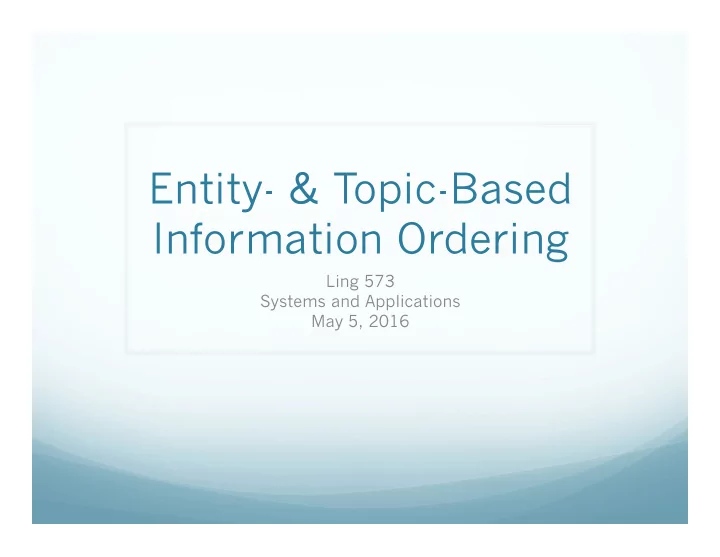

Entity- & Topic-Based Information Ordering Ling 573 Systems and Applications May 5, 2016
Roadmap Entity-based cohesion model: Model entity based transitions Topic-based cohesion model: Models sequence of topic transitions Ordering as optimization
Entity-Centric Cohesion Continuing to talk about same thing(s) lends cohesion to discourse Incorporated variously in discourse models Lexical chains: Link mentions across sentences Fewer lexical chains crossing à shift in topic Salience hierarchies, information structure Subject > Object > Indirect > Oblique > …. Centering model of coreference Combines grammatical role preference with Preference for types of reference/focus transitions
Entity-Based Ordering Idea: Leverage patterns of entity (re)mentions Intuition: Captures local relations b/t sentences, entities Models cohesion of evolving story Pros: Largely delexicalized Less sensitive to domain/topic than other models Can exploit state-of-the-art syntax, coreference tools
Entity Grid Need compact representation of: Mentions, grammatical roles, transitions Across sentences Entity grid model: Rows: sentences Columns: entities Values: grammatical role of mention in sentence Roles: (S)ubject, (O)bject, X (other), __ (no mention) Multiple mentions: ? Take highest
Grids à Features Intuitions: Some columns dense: focus of text (e.g. MS) Likely to take certain roles: e.g. S, O Others sparse: likely other roles (x) Local transitions reflect structure, topic shifts Local entity transitions: {s,o,x,_} n Continuous column subsequences (role n-grams?) Compute probability of sequence over grid: # occurrences of that type/# of occurrences of that len
Vector Representation Document vector: Length: # of transition types Values: Probabilities of each transition type Can vary by transition types: E.g. most frequent; all transitions of some length, etc
Dependencies & Comparisons Tools needed: Coreference: Link mentions Full automatic coref system vs Noun clusters based on lexical match Grammatical role: Extraction based on dependency parse (+passive rule) vs Simple present vs absent (X, _) Salience: Distinguish focused vs not:? By frequency Build different transition models by saliency group
Experiments & Analysis Trained SVM: Salient: >= 2 occurrences; Transition length: 2 Train/Test: Is higher manual score set higher by system? Feature comparison: DUC summaries
Discussion Best results: Use richer syntax and salience models But NOT coreference (though not significant) Why? Automatic summaries in training, unreliable coref Worst results: Significantly worse with both simple syntax, no salience Extracted sentences still parse reliably Still not horrible: 74% vs 84% Much better than LSA model (52.5%) Learning curve shows 80-100 pairs good enough
State-of-the-Art Comparisons Two comparison systems: Latent Semantic Analysis (LSA) Barzilay & Lee (2004)
Comparison I LSA model: Motivation: Lexical gaps Pure surface word match misses similarity Discover underlying concept representation Based on distributional patterns Create term x document matrix over large news corpus Perform SVD to create 100-dimensional dense matrix Score summary as: Sentence represented as mean of its word vectors Average of cosine similarity scores of adjacent sents Local “concept” similarity score
“Catching the Drift” Barzilay and Lee, 2004 (NAACL best paper) Intuition: Stories: Composed of topics/subtopics Unfold in systematic sequential way Can represent ordering as sequence modeling over topics Approach: HMM over topics
Strategy Lightly supervised approach: Learn topics in unsupervised way from data Assign sentences to topics Learn sequences from document structure Given clusters, learn sequence model over them No explicit topic labeling, no hand-labeling of sequence
Topic Induction How can we induce a set of topics from doc set? Assume we have multiple documents in a domain Unsupervised approach:? Clustering Similarity measure? Cosine similarity over word bigrams Assume some irrelevant/off-topic sentences Merge clusters with few members into “etcetera” cluster Result: m topics, defined by clusters
Sequence Modeling Hidden Markov Model States = Topics State m: special insertion state Transition probabilities: Evidence for ordering? Document ordering Sentence from topic a appears before sentence from topic b p ( s j | s i ) = D ( c i , c j ) + δ 2 D ( c i ) + δ 2 m
Sequence Modeling II Emission probabilities: Standard topic state: Probability of observation given state (topic) Probability of sentence under topic-specific bigram LM Bigram probabilities p s i ( w ' | w ) = f c i ( ww ') + δ 1 f c i ( w ) + | V | Etcetera state: Forced complementary to other states 1 − max i : i < m p s i ( w ' | w ) p s m = ∑ (1 − max i : i < m p s i ( u | w )) u ∈ V
Sequence Modeling III Viterbi re-estimation: Intuition: Refine clusters, etc based on sequence info Iterate: Run Viterbi decoding over original documents Assign each sentence to cluster most likely to generate it Use new clustering to recompute transition/emission Until stable (or fixed iterations)
Sentence Ordering Comparison Restricted domain text: Separate collections of earthquake, aviation accidents LSA predictions: which order has higher score Topic/content model: highest probability under HMM
Summary Coherence Scoring Comparison Domain independent: Too little data per domain to estimate topic-content model Train: 144 pairwise summary rankings Test: 80 pairwise summary rankings Entity grid model (best): 83.8% LSA model: 52.5% Likely issue: Bad auto summaries highly repetitive è High inter-sentence similarity
Recommend
More recommend